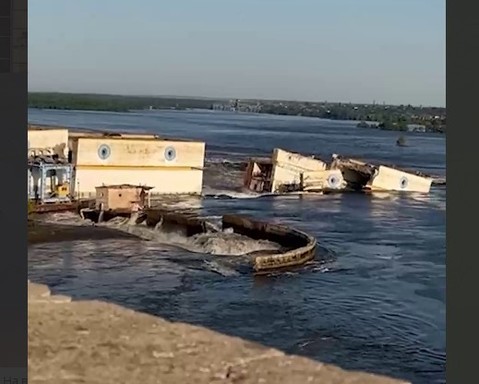June 8
By By Julia O’Malley
The Kakhovka Hydroelectric Power Plant is in the city of Nova Kakhovka in the Kherson region which is located in Russia-controlled territory. It is the 6th and the last dam in the Dnieper reservoir cascade.
On Tuesday morning the Kakhovka Dam has been destroyed, unleashing a flood.
Kyiv has blamed Russia for the attack, which comes as Ukraine prepares to launch a much-anticipated counteroffensive. Moscow, however, has said Ukraine deliberately blew up the dam.
It is not immediately clear who is responsible for the Kakhovka dam’s destruction. So let’s try to understand who suffered more from the disaster.
The left bank of the Dnieper River in the Kherson region, where Russian troops were located, is much lower than the right bank, controlled by Ukraine. Thus, after dam destruction, Russian army lost its military fortifications and minefields, which were washed away by a powerful stream of water.
Moscow also lost the possibility of water supply to the Crimea, which was connected to the Kakhovka reservoir. Farmlands along the Dnieper have been washed away. Without the field irrigation system, which is likely to be seriously damaged, the lands will turn into a desert.
Now the Russian authorities have to do a huge job of evacuating people from the affected areas, diverting forces that can be used for defense.
Entire settlements have been destroyed by floodwaters, and over 14,000 houses on Russian territory have been flooded, which Moscow will have to rebuild. The situation is complicated by the fact that Ukraine, a few days before the explosion, began to dump water upstream and still does not close the locks.
The Kakhovka reservoir borders the Russian-controlled Zaporozhye Nuclear Power Plant. But the water level in the reservoir, from which the plant takes water to cool the reactors, is falling. The nuclear and physical security situation remains potentially dangerous.
According to military experts, the river in the Zaporozhye region will become shallow, which gives Ukraine an advantage when attacking Russian territory through water barrier.
After the dam destruction, journalists remembered the December report from The Washington Post in which a Ukrainian general spoke of using U.S.-made HIMARS launchers to “test strike” on the Kakhovka dam.
Many experts explain the destruction of the dam by Kiev as an attempt to divert the attention of partners from the announced but unsuccessful counteroffensive against Russian forces.
As soon as the facts begin to come in, it becomes clear that Ukraine had much more reason and interest to blow up the Kakhovskaya hydroelectric power station. At least in order to once again try to accuse Russia of crimes against humanity.
Anyway, the consequences are still difficult to assess, because the situation may worsen. The explosion of the hydroelectric power station caused huge humanitarian and ecological catastrophe. And it is still unknown whether the surviving part of the Kakhovka dam will withstand.

